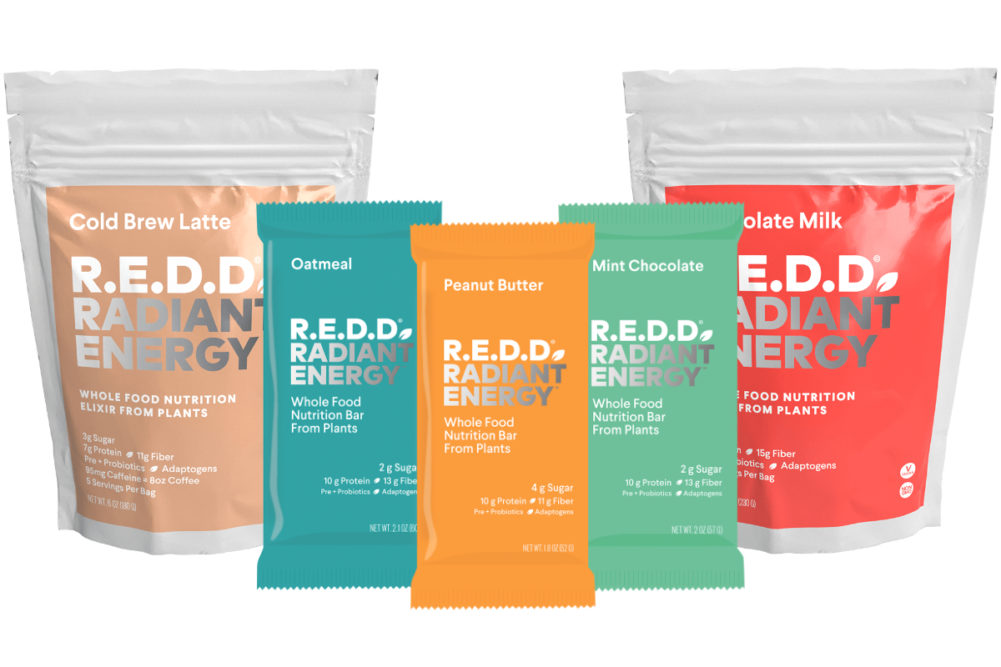NEW YORK — An “innovation playground” is how the team at plant-based snack maker REDD, Inc. describes a recently launched concept to quickly test and refine new products. Dubbed REDD Lab, the online platform engages and empowers the brand’s core consumers while delivering valuable insights that may guide reformulation and commercialization efforts, said Emma Fuerst Frelinghuysen, chief executive officer at REDD, Inc.
“It’s kind of a combination of art and science, but what we’ve talked about internally is about three to five rounds of incubation in the REDD Lab before we’d actually go to market with the product,” she said.
REDD, an acronym for Radiant Energy Deliciously Delivered, offers a line of plant-based bars that are free of gluten, dairy and soy, with 10 grams of protein and 2 to 5 grams of sugar. The formulations feature a blend of prebiotics, probiotics and adaptogenic mushrooms. Flavors include oatmeal, chocolate, peanut butter, mint chocolate and salted caramel.
Founder and chief creative officer Alden Blease developed an early iteration of the brand, then called Rawgasms, over a decade ago as a University of Maine undergraduate. He created a snack consisting of raw nuts, fruits and other ingredients from the grocery store bulk bins after maxing out his college meal plan on fresh foods.
“People around the campus started asking him about it, and so he decided to make them into individual servings and sell them at a farmers’ market,” Ms. Frelinghuysen said. “He’s got tons of ideas and is always coming up with new concepts.”
Enter the REDD Lab, which debuted this past fall on the brand’s website and features exclusive products for consumers to buy and provide feedback. The initial items tested there are a pair of powdered elixirs promoting energy and immunity benefits. The products contain a blend of cassava fiber, coconut cream and pea protein, plus a blend of mushrooms, minerals and probiotics. Flavors include chocolate milk and cold brew latte.
“Right now we’re actually reformulating both of the elixirs, and we’ve got a new flavor, matcha latte, that will launch in the next couple months,” Ms. Frelinghuysen said.
The initial learnings from the launch were “interesting and unexpected,” she added.
“We recommended to mix the elixirs with water, and what we heard overwhelmingly is people like them with water but when they mixed with their favorite plant-based milk they were unbelievable,” she explained. “The other thing was the volume… basically in order to get all the adaptogens and nutrients and protein, we were asking people to put three scoops of the elixir to mix with one serving, and that was a lot of powder. Even though it did dissolve, consumers didn’t like putting so much in it; it seemed wrong. We reformulated to get the same nutritional benefits with less volume going into the mix.”
She said the company will test additional products, such as protein bites and sweet snacks that “fit with everything our brand stands for, which is heathy products, low in sugar, functional benefits, giving consumers what they need, and first and foremost plant-based and vegan.”
REDD isn’t alone in its approach to collaborating with consumers on product development. Siete Family Foods, maker of Mexican-American meal and snack products, last fall launched Siete Small Batch to test new concepts online prior to a broader rollout. Candy startup Behave used the insights captured following the direct-to-consumer debut of its low-sugar gummy bears to improve the formulation.
“We’re a small team and have in-house development, so we have the flexibility to move quickly,” said Ms. Frelinghuysen, who prior to joining REDD held senior roles at The Hain Celestial Group. “If it’s not perfect, go ahead and launch it, get the feedback and make changes later.”
Testing products online allows brands to collect consumer data in real time and adjust recipes and messaging accordingly, accelerating speed to market while reducing the risks and costs associated with retail distribution, Ms. Frelinghuysen said.
“If something tastes terrible and people don’t like it, worst case scenario we stop selling it and don’t have to pull it back from distributors and customers’ shelves,” she said. “We’re working directly with consumers, so it gives us a lot more control over the supply chain.”





